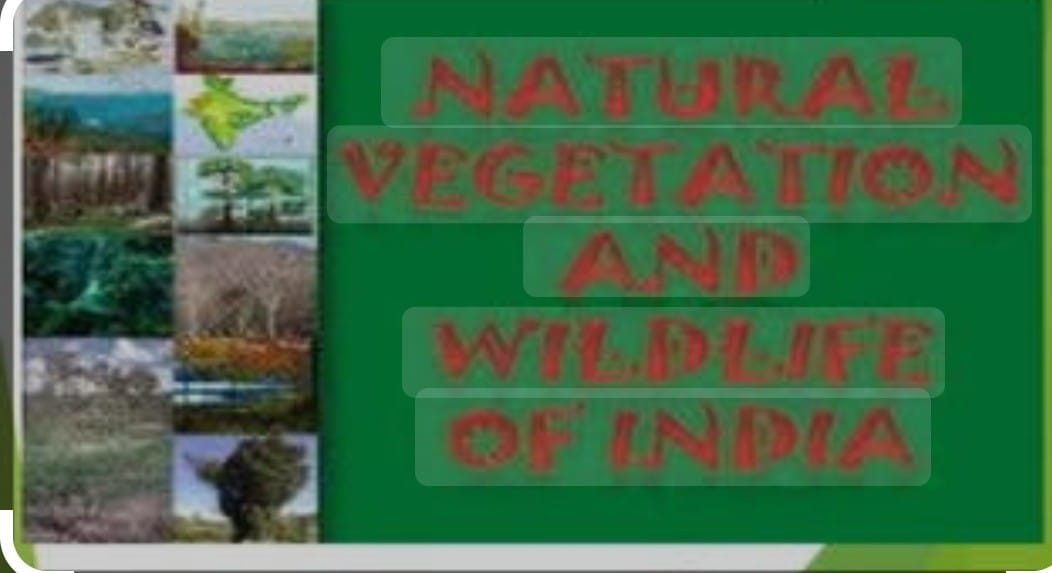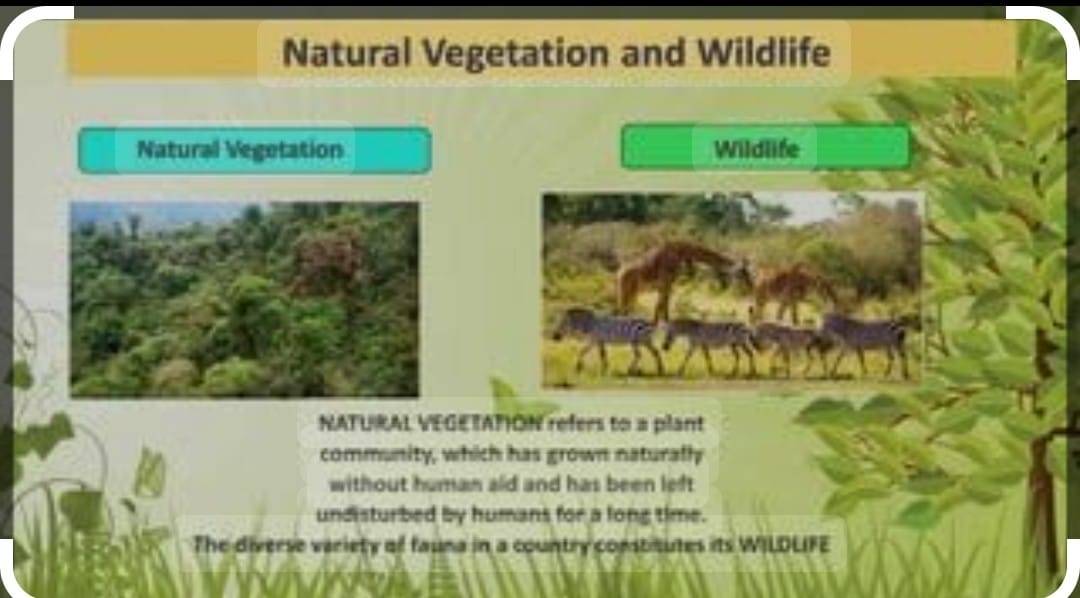Natural Vegetation and Wild life
Natural Vegetation and Wild life is the Chapter from Geography of class 9 covering the complete text and syllabus of class 9

NATURAL VEGETATION refers to a plant community which has grown naturally without human intervention for longtime. It is also termed as Virgin Vegetation .
On the basis of it’s residence are of two types
i) Endemic are those which are purely native
ii)Exotic are those which are brought for some other place long ago.
The term Flora is used to denote plants of a particular region period and the species of the animals are referred as Funa

NATIONAL PARK :
Habitat for particular plant / wild animal eg Jim Corbet is the national park for the tiger reserve , size range is .4- 3162 sq km tourism permissible .
SANTUARY
It is the natural aera reserved for the species – oriented plant/animals eg Manas Bird Sanctuary general size range of .6 to 7818 sq km and tourism permissible .
BIOSPHERE RESERVE
It is the natural aera meant to reserve all form of life ie ecosystem oriented such as Simlipal Bio reserve. The size 5670sq km but not permissible for tourism.
LAND,SOIL , TEMPERATURE ,SUNLIGHT AND PRECIPITATION are the important factors affecting the flora and fauna of the place.
LAND :
The nature of land influences type of vegetation as undulating and rough terrains developed into a verity of natural wildlife as compared to fertile land which is used for agriculture
SOIL:
There are different types of soil support different vegetation sandy soil supports thorny bushes where as deltaic soil support mangrove vegetation
TEMPERATURE :
we can see that tropical aera has verity of vegetation as compared to temperate region. More-over as we go to the higher altitude, vegetation cover changes from temperate forest to grassland to tundra and finally alpine type .
PRECIPITATION
It is the heavy rainfall aeras have generally dense vegetation cover as compared to scanty rainfall are aeras.
SUNLIGHT ;
Itis observed that due to longer duration of sunlight trees grows faster in the summer as compared to the other season of year
ECOSYSTEM
The system of interaction among biotic component and their interaction with abiotic component of a particular aera is called ecosystem . such as pond ecosystem , river ecosystem, lake , forest and grassland
Ecosystem is classified into
a) Biotic Component such as producers as plants , consumer as human being and decomposer as bacteria and fungi .
b)Abiotic component such as climate factor like rain, wind and temperature soil and mineral
Types of Ecosystem :
a) Terrestrial land which consist of forest, grassland and desert
b) Aquatic further divide into pond, lake river and Estuary.
A very large ecosystem of an aera having distinct types of flora and Fauna is called Biome
BIOSPHERE ==.> BIOME ==>ECOSYSTEM ===> COMMUNITY ===>POPULATION =>INDIVIDUAL are related to each other.
IMPORTANCE OF FOREST :
It gives medicined , supply of oxygen , It supply manure ,
It is controlling floods and land degradation,
It is natural Habitual to wild life ,
It maintaining the climate a place, supply of food stock ,
It helps the preventing soil erosion and maintaining the fertility , the it control temperature of a place
It provides fuel and also help in bringing rain
CHARACTERISTICS OF DIFFERENT TYPES OF NATURAL VEGTATION ;
i) TROPICAL EVERGREEN FOREST
are those which have rainfall more than 200cm they are having warm and wet climate. Trees shed leaves at different times of the year , the heigh of the trees is more than 60 m . It has very dense and forms canopy it’s woods are hard .
Wildlife are elephant, monkey , lemur ,deer , verity of birds , sloth Scorpio and snakes mostly found in western ghats, Andaman and Nicobar Island , Lakshadweep ,Assam and Tamil Nadu
ii) TROPICAL DECIDUOUS FOREST
is classified into Wet Deciduous having rainfall of 200-100 cm and Dry Deciduous with rainfall of 100cm – 70 cm they have same variety of tree , it shed their leaves at the same time of the year woods are moderately hard such as teak, Sal , shisham , bamboo , khair sandalwood , Arjun Mulberry , Pipal and Neem
wild life found are Lion, tiger, deer, pig, elephant , Variety of birds lizards , snakes and Tortoise it is found in aera of Jharkhand ,Orissa ,Chhattisgarh , Northern eastern states , Bihar and UP
THORN FOREST AND BUSHES
is the area having less than 70 cm rainfall . Mostly thorny bushes and trees. Trees are deep rooted . Leaves modified into into spine and stem have waxy coating to reduce loss of water .
Acacia, Palm , Cacti and Euphorbias Rats, mice rabbits fox wolf wild ass camel it is found in Gujarat, Rajasthan, arid region of MP , and Chhattisgarh Haryana
HIMALAYA MOUNTAIN FOREST
is classified between 1000-2000m is wet temperate forest which have broad leaves and soft wood oak and chestnut are found, 1t the height of 1500m – 3000m temperate forest are found where we find cone shape trees , needle like leaves to protect from snow deposition ,at the higher level grassland is found Pine, deodar silver fir , spruce cedar.
Kashmir stag , spotted bear , sheep jack rabbit they are found in Jammu and Kashmir , Himachal Pradesh , Uttarakhand . Alpine Vegetation is found at the height more than 3600 m the grassland used by pastoral nomads of that aera Juniper, Pine and Birches Red Panda , snow Leopard are found . Tundra vegetation in which there are no trees and grassland therefore mosses, lichens are found.
Sundari trees has root submerged in saline water provide hard timber Sundari , palm ,coconut agar
Bengal tiger , turtle, crocodiles, gharials ,snakes Delta of Mahanadi , Kavari , Godavari and West Bengal
WILD LIFE PROTECTION ACT was implemented in 1972 in India .
India is only the country where both Lion and Tigers are found .Gir Forest of Gujarat is the last remaining habitat of ASIANTIC LION .
The country has around 90 thousand of animal species, 2000 species of birds ,2546 species of fishes 5-8% of the world’s amphibians, reptiles and mammals.
To protect the flora and fauna the government has taken the following steps
i) Eighteen biosphere reserves have been establish in the country to protect the flora and fauna.
ii) Financial and technical support is provided to many Botanical Gardens by the Government since 1992.
The project Tiger, Project Rhino , Project Great Indian Bustard and many other eco-system development project have been introduced . 103 national parks , 535 wild life sanctuaries and zoological gardens have been set up to take care of natural habitat of the fauna.
POPULAR BIOSPHERE RESERVE :
i)Sundarbans in West Bengal
ii) Simlipal in Odisha
iii) Gulf of Mannar in Tamil Nadu
iv)Dihang and Dibang in Arunachal Pradesh
v)The Nilgiris in Tamil Nadu , Kerala , Karnataka
vi) Dibra Saik Howa in Assam
vii) Nanda Devi in Uttarakhand
viii)Agasthya Malai in Kerala ,Tamil Nadu
ix)Norek in Meghalaya
x) Kanchenjunga in Sikkim
xi) Manas in Assam
xii)Panchami in MP
xiii) Great Nicobar in Andaman and Nicobar Island
xiv) Achan Akmar and Amarkantak in MP and Chhattisgarh
POPULAR NATIONAL PARK FOR WILD LIFE RESERVE :
1) Kaziranga in Assam in 1974 to reserve one horned Rhino , elephant and Tiger
2) Manas in Assam in1990 to preserve roofed turtle, golden langur
3)Gir in Gujarat in1975 to preserve Asiatic Lion
4) Hemis in J&K in1981 for snow leopard
5)Bandipore in Karnataka in 1974 to preserve Asian elephant and tiger
6)Paraiyar in Kerala in 1982 for Nilgiris Languor, Flying squirrel
7) Ernakulum in Kerala in 1978 to preserve Nilgiris Thar , Atlas moth , elephant
8) Bandhavgarh in MP in 1982 to tiger, leopard and boars.
9) Kanha in MP in 1955 to preserve tiger, leopard and elephant
10) Madhav in MP in 1959 to preserve Indian Gazelle , Nilgai , Sambar 11)Panna in MPin1973 for tiger, wolf , chital
12) Keoladeo in Rajasthan in 1981 to preserve the Siberian Crane, Migratory Birds species
13) Ranthambore in Rajasthan in 1980tiger ,leopard and boars
14) Sariska in Rajasthan in 1982 to preserve four horn deer, caracal , leopard
15) Madumlai in Tamil Nadu in 1940 to preserve tiger, leopard , elephant and vulture
16) Corbet in Uttarakhand in !936 for tiger , leopard and elephant
17) Nada Devi in Uttarakhand 1988 to preserve tiger and leopard .
18) Valley of Flowers in Uttarakhand in 1980 snow leopard, musk deer red fox 190Dudhwa in UP in 1977 for tiger and Rhino
20) Sunderban in West Bengal in 1984 Royal Bengal Tiger
Conclusion: Natural Vegetation and Wildlife of India
India has different kind of natural vegetation due to its varied climate and topography which include:
Tropical Rainforests found in the Andaman and Nicobar Islands, Western Ghats, and parts of Northeast India. These are dense forests with tall trees and rich biodiversity. Tropical Deciduous Forests that Cover a large part of the country, shed leaves in dry seasons. Examples teak and sal forests. Thorny Scrub Forests Which is Common in arid regions like Rajasthan, characterized by thorny plants adapted to dry conditions. Mountain Vegetation which varies with altitude, from subtropical forests at lower levels to alpine meadows at higher elevations in the Himalayas. Mangrove Forests is found along the coasts, in the Sundarbans delta which protect coastal aera .
India is home to a rich variety of wildlife include the Bengal tiger, Indian elephant, Indian rhinoceros, and Asiatic lion. The peacock is the national bird. Reptiles including various snake species, crocodiles, and the Gharial. Marine Life including dolphins, whales, and sea turtle
India has established numerous national parks, wildlife sanctuaries, and biosphere reserves. Project Tiger is successful conservation initiative to protect Bengal tigers Indian Wildlife Protection Act Provides legal protection to wild animals, birds, and plants.
We have to face lots of challenges in this regard due to deforestation and urbanization, human settlements expand into animal habitats. Illegal hunting still a threat to many species .
Follow Us on : Facebook and Instagram
Read More: Drainage , Climate , India size location